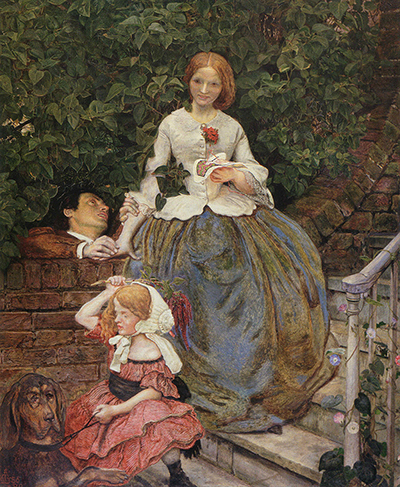Well, if sadism had a face, then this century-old art piece would be the exact representation. It captures a cruel scenario of pleasure in one at the expense of another’s suffering. Stages of cruelty is one of Brown’s genius graphics, born of decades old-times and exquisite inspirations from notable artists of the past.
A woman is seated by a staircase, smiling, holding flowers in one hand. Her other hand is gripped by a man who is in need. In need of the woman’s love. Or, maybe just a glimpse of it. She is oblivious to him. Not even looking his way. A clear sign of rejection. What a poor man? He is determined, still looking on, hoping, eyes filled with pity. The woman is smiling, enjoying this infinite attention. Yet, not returning a shred of it. She finds satisfaction in the man’s misfortune. Down at the woman’s feet is a child, a girl. Her face is expressionless, cold. She has a branch in hand, and she uses it to hit a dog, a poor sad-faced bloodhound next to her. What has the hound done? One wonders.
The vices of human nature are depicted here. Compassion denied and abuse done to the unfortunate: The stages of cruelty. The painting is crafted from oil on canvas, housed at the Manchester art gallery. It was painted over decades, four decades to be precise (1856- 1890). Brown commenced it without proper approval and then halted at some point along time. The painting was completed later on and then claimed by Boddingtons brewery.
Its original title was "stolen pleasures are sweet". Then, in 1860, it changed to "stages of cruelty". Inspirations were drawn from Arthur Hughes’s painting, "April love". This depicted aftermath of an argument, a woman, turning away from a lover. Another inspiration came from William Hogarth’s collections of engravings of four stages of cruelty. Therefore, one can say the art has practically metamorphosed to perfection over time.
There are other works of art by Ford Madox Brown, a French-born British painter. Most of them are based on morality and history and Pre-Raphaelite style. One of his distinct works was work (1852-1865), an allegorical painting that rhymed with its title. An illustration of the market place. Ford Madox Brown is one of the art geniuses whose works resonate in the world of art from time to time.




